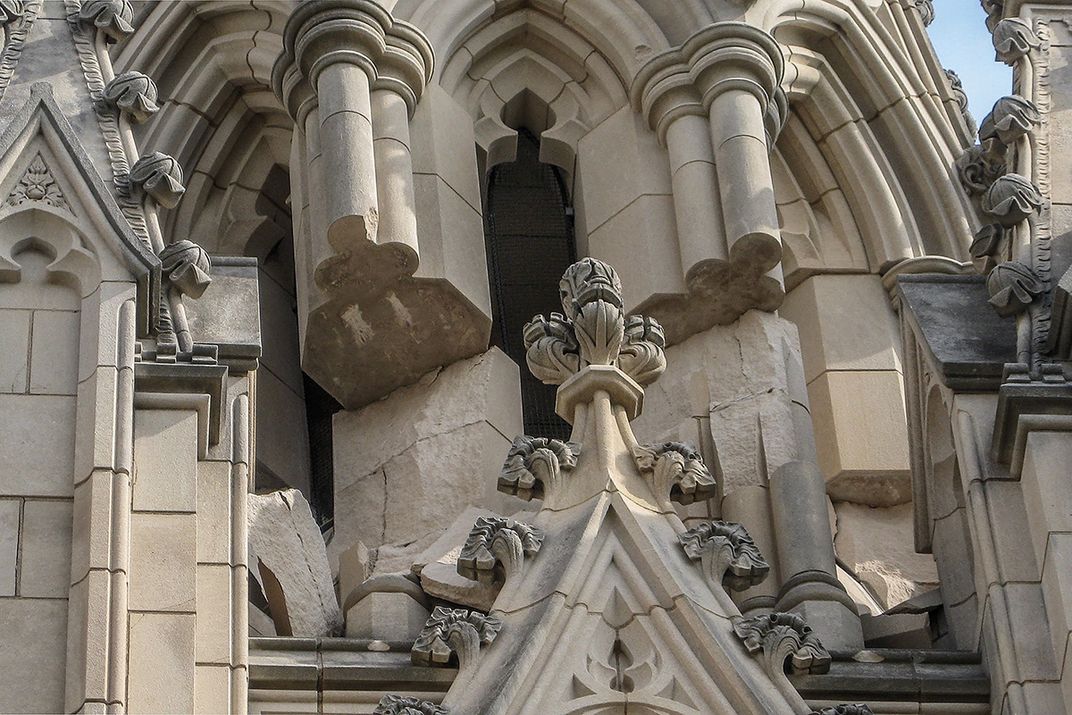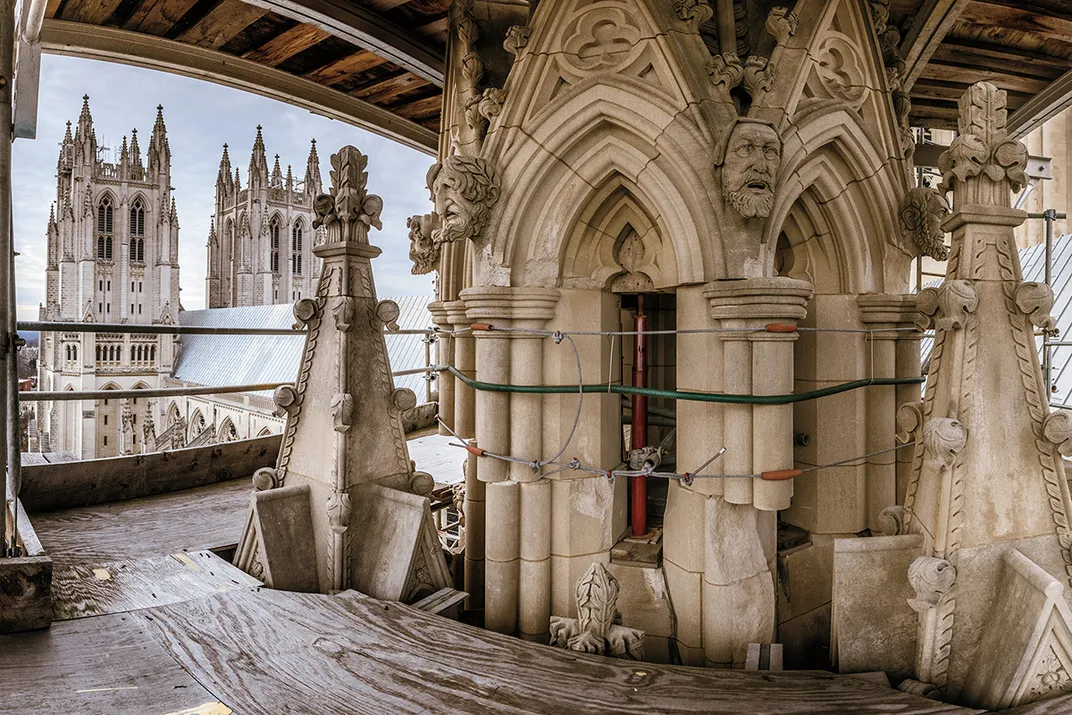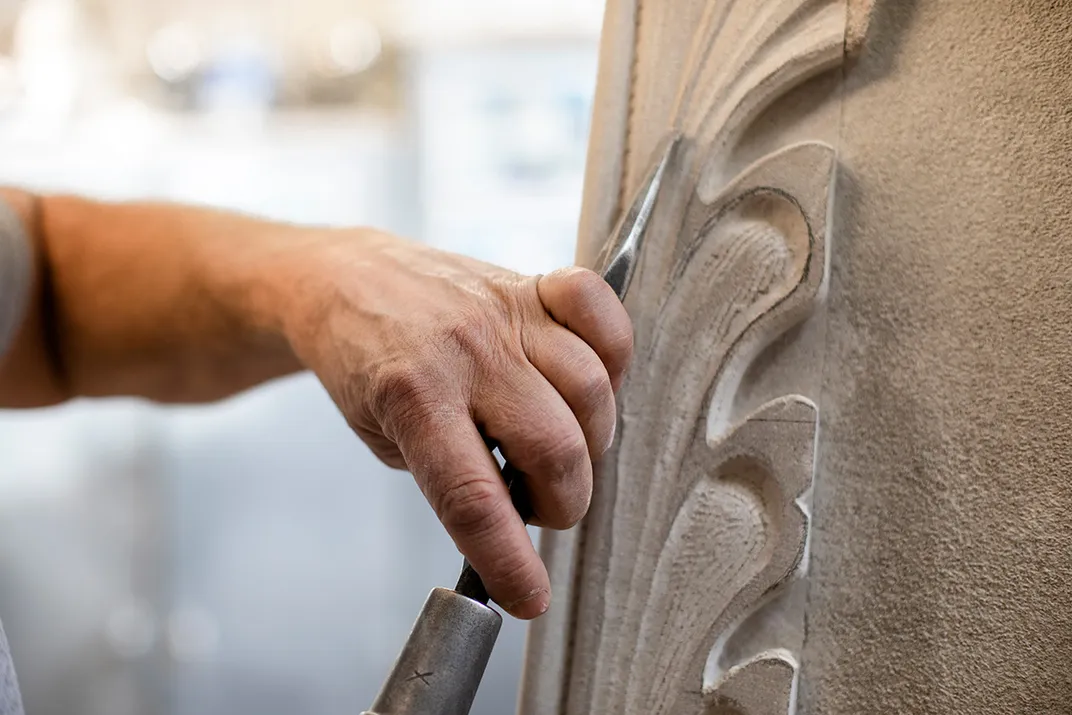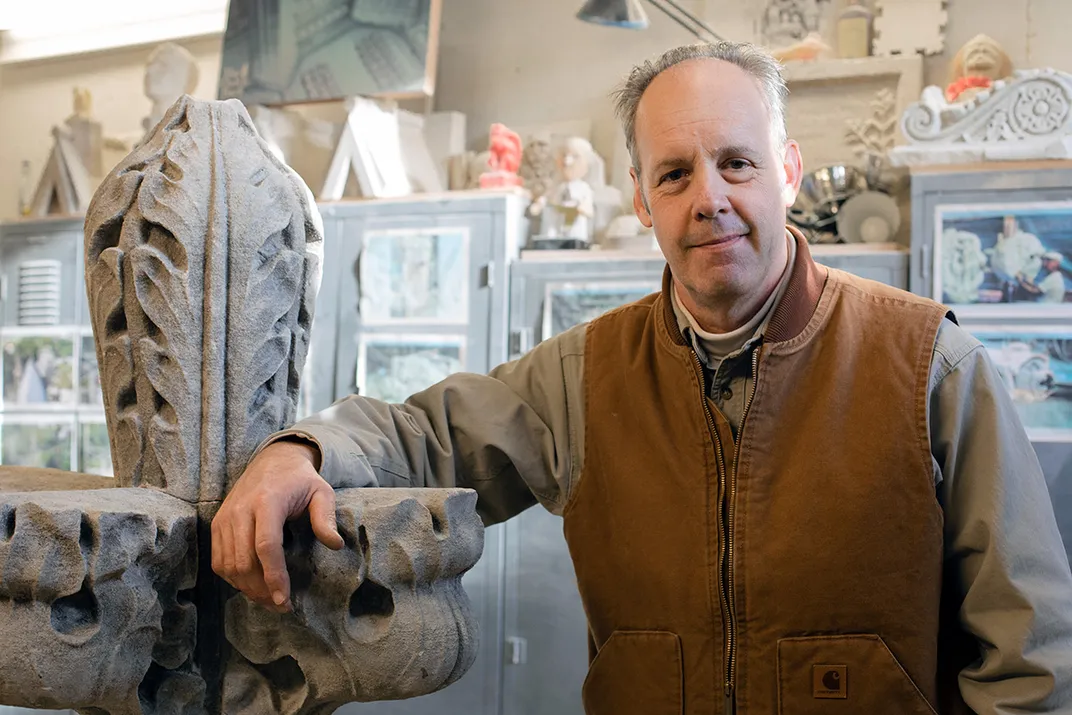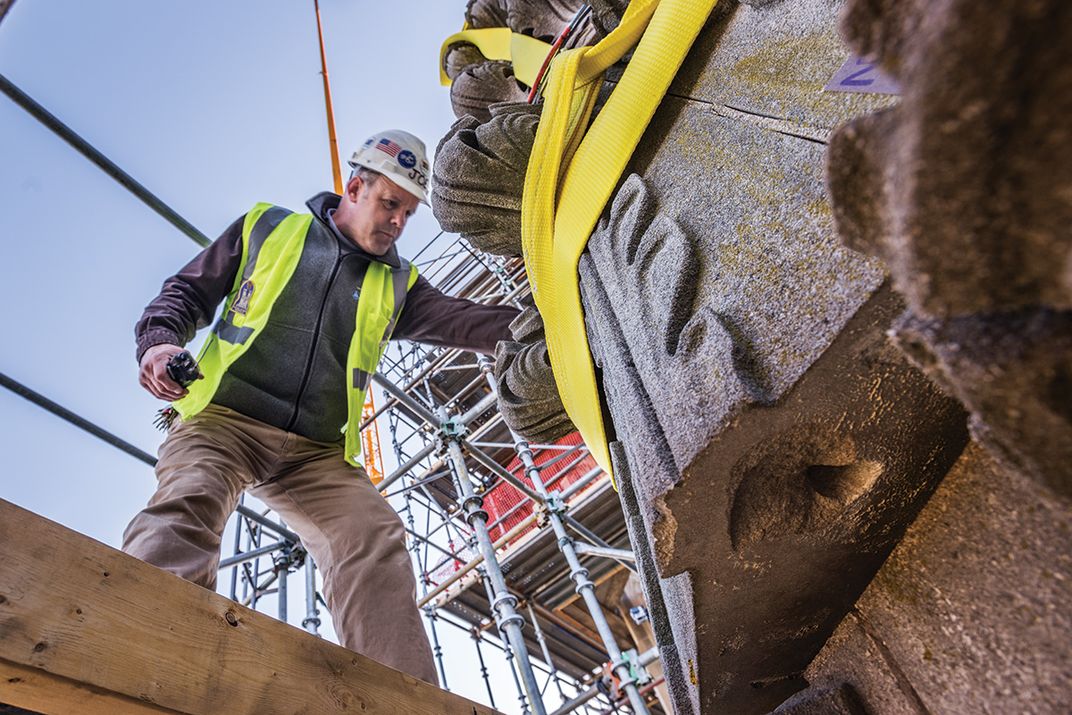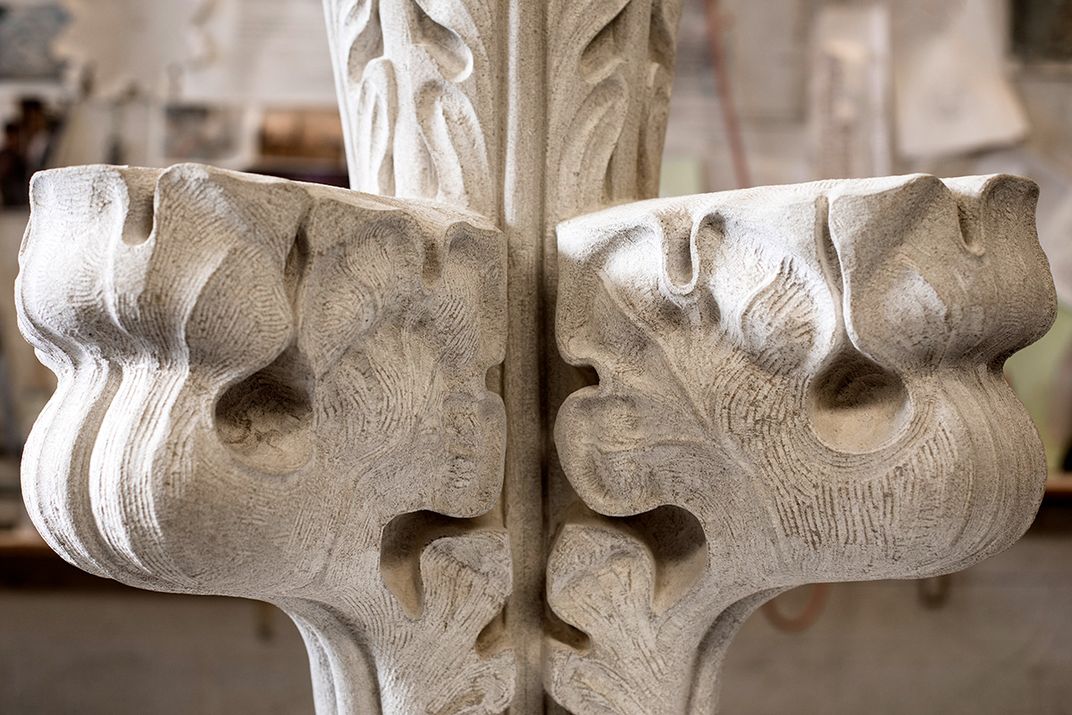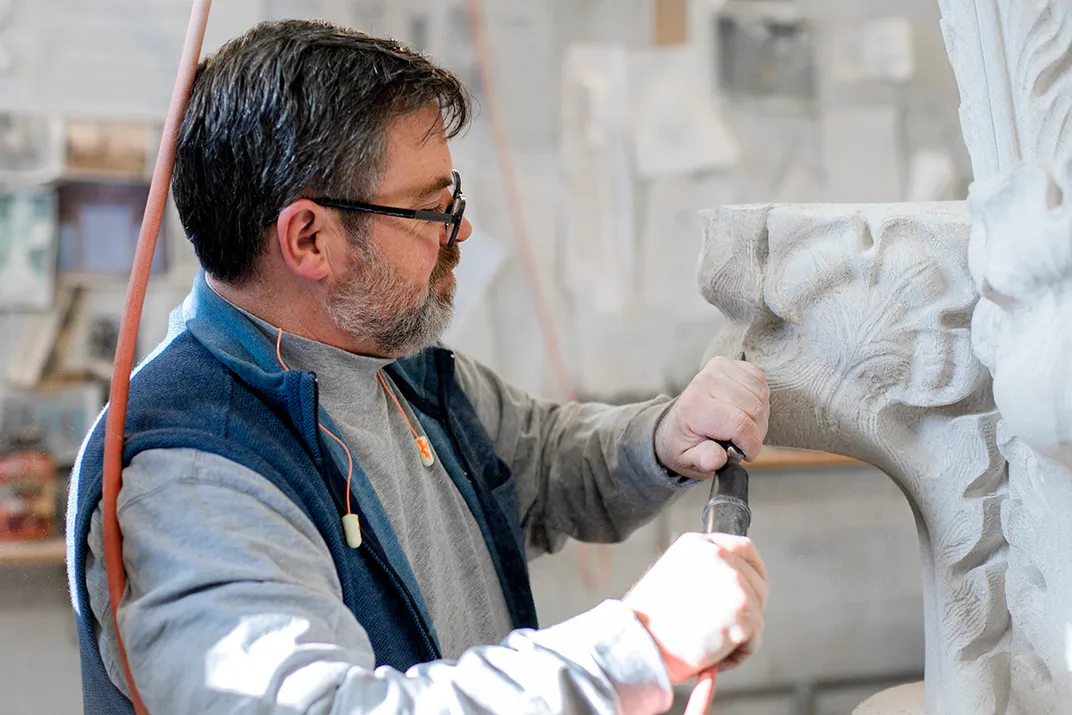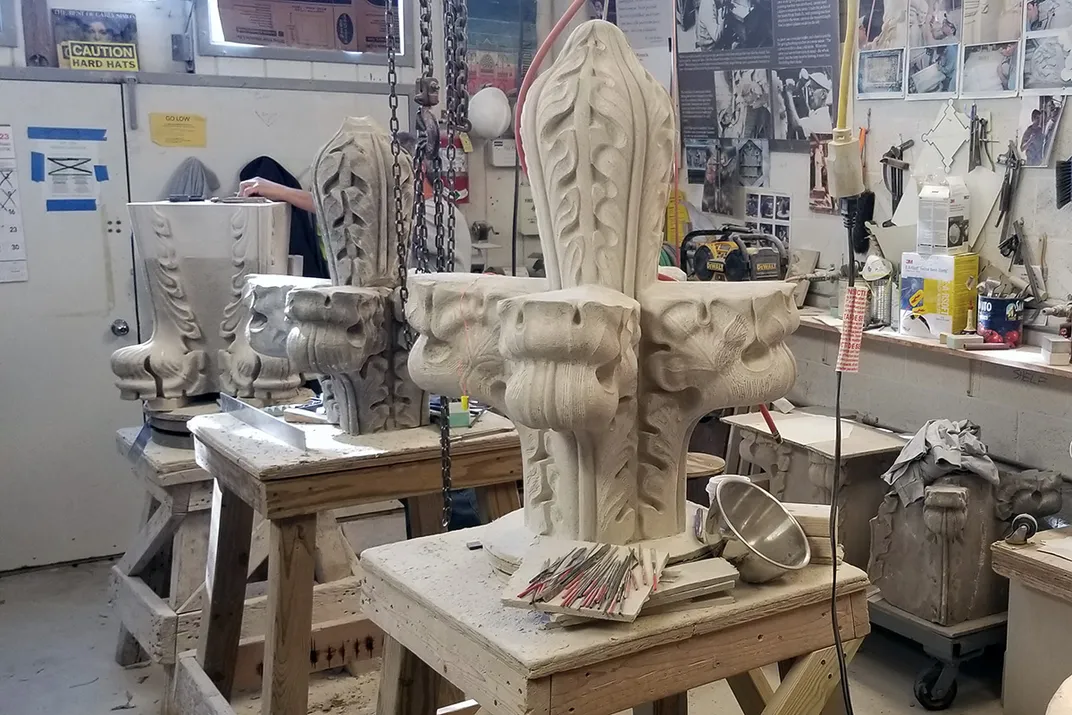The Decades-Long Journey to Restore the National Cathedral
Craftspeople in the building arts are practicing “social distancing stone masonry” in safeguarding this cultural heritage
:focal(451x205:452x206)/https://tf-cmsv2-smithsonianmag-media.s3.amazonaws.com/filer/0a/52/0a52f74b-7799-4094-a7c4-28981a91914f/national-cathedral-scaffolding.jpg)
High up on scaffolding on the southeast side of the Washington National Cathedral, the cathedral’s longtime head stone mason Joe Alonso works six feet apart from the nearest craftsman as they carefully disassemble and remove dangerously loose pinnacle stones dating back to the 1920s with the aid of a giant crane.
During the COVID-19 crisis, construction work has been deemed essential by the mayor of Washington, D.C., and Alonso and his crew of skilled masons and carvers are taking every precaution—practicing, as Alonso puts it, “social distancing stone masonry.” Spreading out across multiple scaffolding decks, with each craftsman wearing a protective mask, they continue their ongoing efforts to safeguard and restore the cathedral, a magnificent 14th-century Gothic-style landmark that was severely damaged when an earthquake rocked the city on August 23, 2011. For Alonso and his team, it has been a long and unexpected journey.
The earthquake’s seismic energy shot up through the cathedral’s highest elements “like the tip of a whip,” shaking its intricately carved pinnacles and slender spires, sending finials and angels plummeting, causing heavy stones to rotate dramatically and flying buttresses to crack. “It was like a punch to the gut,” says Alonso, describing the shock and disbelief he felt as he surveyed the damage for the first time from the top of the 300-foot central tower.
Decorative carvings lay shattered in pieces on the roof and in the gutters. Giant stones that make up the four grand pinnacles of the central tower had shifted almost completely off their mortar beds and were perched precariously, looking “like a game of Jenga.” Three of the four pinnacles were missing their tops. The 500-pound, four-foot-tall finials that crown them had crashed to the tower’s roof. “Seventy-five percent of the highest elements rotated,” says James Shepherd, the cathedral’s director of preservation and facilities from 2003 to 2019.
“Boom! It went up through the tops of everything,” Alonso says. “We’re lucky it didn’t last a few seconds longer.”
All told, the cathedral sustained a staggering $34 million in damage. As funding comes in from generous donors, the staff has been able to tackle the earthquake restoration work in phases, making slow but impressive progress, including critical masonry repairs and reinforcement to the west towers, flying buttresses and north transept. But after nine years, there is still $19 million to raise and a monumental amount of work to accomplish.
Faced with devastating damage and a massive restoration effort, the cathedral has a major asset in its favor: three highly skilled craftsmen who helped to build the structure and have been working for years to maintain and preserve the 113-year-old national treasure: Alonso and stone carvers Sean Callahan and Andy Uhl.
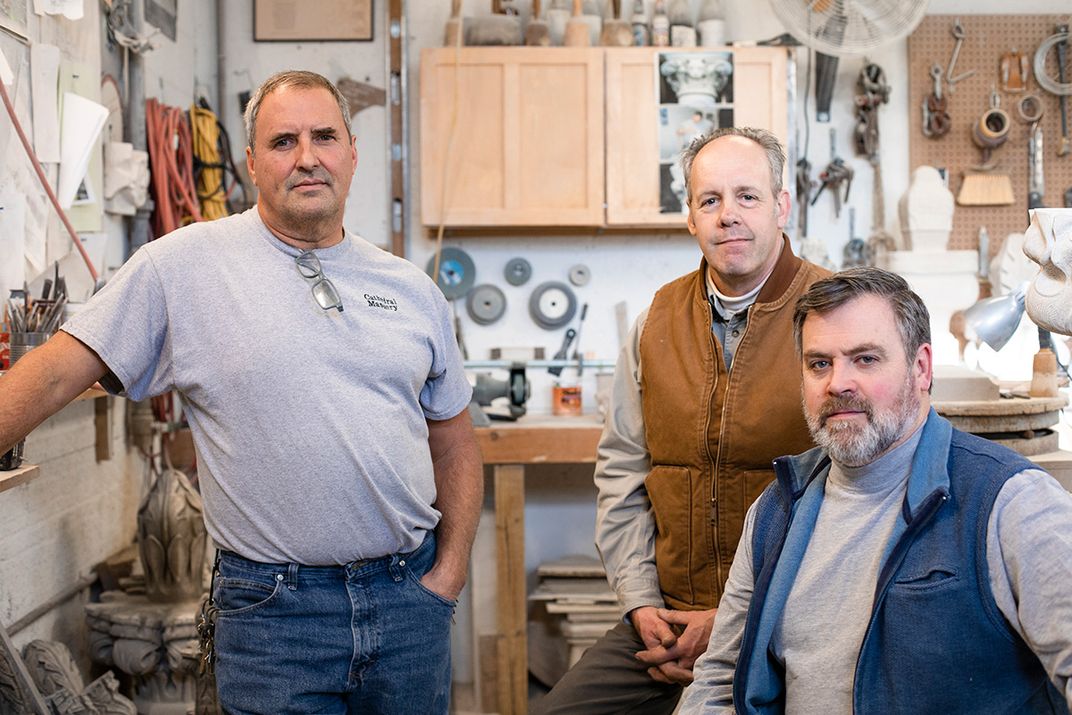
The Artisans
Leading the cathedral’s team of craftspeople, Alonso is a master builder who has devoted 35 years of his life to the cathedral, first as a stone mason helping to construct this monumental building, and then as the head mason in charge of caring for the century-old stonework, preserving the fine craftsmanship of generations of masons and carvers. “I know every crack in this place,” he says.
Alonso first came to the cathedral in 1985 to help craft the west towers. He was already a seasoned journeyman mason. But, he is quick to point out: “I almost had to start from scratch. No one builds 14th-century Gothic stonework anymore, these thick, load-bearing masonry walls, arches, tracery. It was like learning the trade all over again, this style of stonework.”
He had the benefit of learning on the job from legends in the trade like master masons Billy Cleland and Isidore Flaim, and longtime dedicated workers like Otto Epps, all of whom generously shared the knowledge and skills they had learned from the craftsmen who came before them. “They were great teachers,” Alonso says of the time and care they spent showing him different techniques, tools and methods required for properly handling and setting the cathedral’s large, heavy, intricately decorated stones. “Billy expected perfection. He expected the best. The standards have always been so high on this building, the craftsmanship, from day one. So that’s ingrained in you working here, knowing that you need to keep it going, step it up.”
The construction of the Washington National Cathedral began in 1907 and took 83 years to complete. Over the course of nearly a century, hundreds of artisans—stone masons, stone carvers, woodworkers, stained glass artisans, ornamental blacksmiths and many others—built its soaring towers and flying buttresses and crafted the many gargoyles, grotesques, angels and countless other decorative details that are an integral part of Gothic design. Heir to the accumulated knowledge of generations of craftspeople, Alonso not only brings his specialized skills to the earthquake restoration efforts, but a commitment to excellence and a deep sense of connection to the masons who came before him.
“Just seeing their work, the work itself speaks to me,” he says. “When you’re walking way back on the apse, or the great choir, built back in the 1910s and 1920s, and seeing the work they did, they actually set the standard for us as we were building the last portions of the cathedral. At least I felt that when I was up there. It had to be as good as their work.”
On September 29, 1990, exactly 83 years after the laying of the foundation stone, Alonso was given the great honor of setting the cathedral’s last stone: the final grand finial on the southwest tower. He says it felt like all the other masons were up there with him, “maneuvering that big finial into position, checking it, making sure it was level and true.”
Working together with Alonso are journeymen stone carvers Sean Callahan and Andy Uhl, both of whom learned their craft at the cathedral in the 1980s, apprenticing with former master stone carver Vincent Palumbo, a fifth-generation carver who learned the trade from his father and grandfather in Italy before immigrating to the United States in 1961. Palumbo worked at the cathedral for more than half his lifetime—39 years—until his death in 2000. In a small carving workshop bustling with about a dozen apprentices, he taught Callahan and Uhl how to carve finials, angels, crocket stones and other decorative details of Gothic architecture destined for the rising west towers.
Both men feel that learning the craft in a production setting was key to their training, for they acquired not only the skills necessary to carve Indiana limestone into Gothic-style shapes, but the ability to create quality work with speed, precision and efficiency. “There’s an expectation of output, and that’s a good thing,” Callahan says. “They wanted you to get it done and out of the shop, so there’s a time pressure.”
“Learning it from a practical standpoint was really helpful,” Uhl agrees. “You need to be fast and good.”
As the work on the cathedral neared completion, Callahan and Uhl left in 1989 to work on the restoration of the White House and other jobs in the area. Uhl returned to the cathedral in 2004, and Callahan in 2005, to devote their time and talents as carvers and masons to the maintenance and preservation of the building. Occasionally, they carved new pieces of sculpture, ornament, or lettering, as needed.
All that changed dramatically after the 2011 earthquake, when the craftsmen leapt into urgent stabilization, restoration and reconstruction mode. Fortunately for the cathedral, they had the perfect team of artisans already in place.
“There’s not many guys who have come up in this Gothic cathedral carving world,” Alonso says. “Thank God that we’ve got these guys who honed their skills on the west towers. We’ve got the talent with Andy and Sean to do the fine Dutchmen repairs and re-carving of entire pieces that fell off.”
“We’re in a unique situation,” Callahan says. “We learned here, and then we ended up being employed here again, so when the earthquake happened, we knew what to do. We have the intimate knowledge of how it’s done. It’s a nice way to pay back the cathedral for teaching me.”
The Work
Alonso describes the swirl of activity in the first few days and weeks after the earthquake as “masonry triage.” The first step was to inspect and assess the damage, working to stabilize and secure unstable stones, making the building safe. They quickly assembled a team of architects, engineers and the cathedral’s crew of craftsmen to chart a course of action for stabilization, restoration and repair. “We have a great team, a very collaborative team. Our voice is at the table, and I appreciate that,” Alonso says.
“The Cathedral stonemasons’ rare perspective was perhaps the greatest blessing of all,” wrote Leigh Harrison in Cathedral Age. “The three-man team had the background and skills to make knowledgeable and immediate judgments.”
One of the first crucial tasks was to erect scaffolding in order to “get up to the work,” which in most cases is hundreds of feet off the ground. Alonso worked with the engineers and the scaffolding company as they designed and constructed the scaffold. “Scaffolding a Gothic cathedral is probably the most complex scaffolding there is, with all the flying buttresses and pinnacles and buttress arches,” he says. “I’ve been around here so long, I know exactly what’s required, what kind of scaffold. ‘We need to get to the top of all these pinnacles, we need this many working decks, here’s your access, you can tie into the wall here.’ All this weird stuff that’s in my head!”
Wherever possible, the team has dismantled and removed the most severely damaged and unstable stones, relocating them to a storage area on the cathedral grounds or the stone mason’s shop for repair or replication. Steel cables and the strong metal support beams of protective scaffolding hold other stones in place until the necessary repairs can be made. Alonso, Callahan and Uhl work closely with a crew of skilled masons from Lorton Stone, the stone contractor hired to assist with the earthquake restoration.
Alonso has played a key role, sharing his firsthand knowledge of how the elaborately embellished pinnacles are put together, how to properly rig the ornately carved stones so that when they’re lifted “you don’t pop the whole corner off,” how to work with the operators of huge cranes to safely hoist and guide the heavy stones off the towers and down to the ground, and then, later, re-set the restored elements back in place. The opportunity to pass on his expertise to some of the young masons from Lorton Stone has been a keen source of satisfaction. “I’ve kind of taught these guys what Billy taught me,” he says.

On top of the west towers, Alonso had the “heartbreaking” job of dismantling some of the very pinnacle stones he once set in place, while Uhl and Callahan came face-to-face with angels and finials they had carved in the 1980s.
“I never thought we’d be taking the cathedral apart,” Alonso says.
In 2017, the masonry crew was able to restore, reinforce and reassemble the west towers’ twin pinnacles and remove the scaffolding. But the steel frames—visible today from all across the city—that shroud the top of the severely damaged central tower remain. They will secure the stones in place until funding comes to repair and rebuild the pinnacles to their former glory.
While the disassembled stones are on the ground, Callahan and Uhl work to restore them in the stone masons’ shop, a small, evocative space filled with tools, templates, old photos, and architectural drawings, with chain hoists, sturdy wooden work benches, stone dust, and carvings.
“Our goal is to save as much of the historic fabric as possible,” says Jim Shepherd, one of the central figures to lead the earthquake restoration efforts. In his view, the cathedral is lucky to have carvers like Callahan and Uhl who have the “speed and skill” necessary to do the work in a way that is efficient, cost effective and honors the high standards of the early craftsmen.
The carvers assess each stone. “If we can’t save a piece, we’ll re-carve the whole thing, but we try to save as much of the original as we can,” Callahan says. The most common kind of stone repair is called a “Dutchman.” Many of the pinnacle stones have broken corners or edges cracked off from the severe shaking. With hammer and chisels, the carvers cut out damaged sections to create a clean, flat surface. They then fit or “graft” a replacement block of stone snugly in place, securing it with epoxy and stainless steel pins, and carefully carve the stone “patch” to recreate the original. The trick is to get a perfect match.
“Indiana limestone is pretty consistent in color, so color matching is not a big issue,” he says. “You want to try and get the texture right.”
“The hardest part to disguise is the joint itself. A nice tight graft is what we’re going for,” says Uhl, who is working on a Dutchman repair to a four-crocket stone for a pinnacle on the south side of the choir. He experiments with different tools, seeking to replicate the texture of the old piece. “I’ve gone to the old tool cabinet here, where we have a bunch of antique chisels. I saw an end finish on something and took an old tooth chisel and started laying it into the grooves of the original stone, and saying, ‘Hey this might be the exact tool that guy used. It seems to fit.’ You have to just feel your way through it and see what gives you the best result, and when you find it, it’s very satisfying.”
Callahan and Uhl have deep respect and admiration for the work of the original craftsmen. When a carving is “too far gone” to repair, they strive to faithfully recreate its style and workmanship in a new piece of stone. “We’re trying to honor the original,” Callahan says. “This piece here, this finial, fell off the south nave wall on the choir end and broke into several pieces. We decided it wasn’t worth salvaging, but we can use it to copy a new piece. I’m taking templates and measurements of it to reproduce it as a brand new piece.” As he works at his banker, pneumatic hammer and chisel in hand, he constantly refers to the broken finial on the work bench next to him, keeping a sharp eye on its subtleties of style and movement.
“I’m trying to get the sweep right,” he says, emulating the distinctive handwork of the craftsman who first created the carving one hundred years ago. “I ended up doing a lot of this freehand. I’m focusing now on getting his textures, because he left it very coarse. I always try to get nice smooth consistent lines, a nice flow, but he didn’t do that. He left it very choppy and very loose. So I’m actually changing the way I even hit with my hammer, just to try to get his attitude in my motion.”
The historic importance of the old pieces, the fact that they embody and carry forward the craftsmanship of the past, influences Callahan’s approach to his work. “When we were apprentices, everything had a pattern and a template to follow. You copy that shape, but it’s yours. You’re not hyper-focused on getting it just like the carver’s stone on the banker next to you. But here, now, it’s a historical piece, and I’m trying to get it as faithfully like the original as I can.”
“This guy did it a little differently than I do. He didn’t use templates the same way I did. It looks like it was a lot more freehand. So what I ended up doing, I can’t get an absolute template that’s right for each side, I’m just going to try and freehand it and mimic his style as best I can and get his movements the same.”
Alonso speaks with excitement about the opportunity the earthquake scaffolding has given them to view the craftsmanship on the oldest parts of the cathedral at close range. “The access that we now have to different parts of the building, the tops of the pinnacles of the central tower that I thought I’d never touch, just being up close to the work of the people who came so many years before us, is incredible. Andy and Sean love to be up there with all that old carving.”
“You can tell how the carving evolved over time, the way they embellished,” Callahan says. “The older stones are much more organic. They’re not as precise.”
“We see lots of subtleties and differences in the carving in various parts of the cathedral,” Uhl adds. “On the oldest part, you see how free and loose it is, and the nice movement they got. They left the edges rough. It seems so coarse, but when you stand back, it really reads well. We’re like, ‘Hey, this is nice work!’”
When asked if they can tell there were different carvers working up on the central tower, their response is immediate. “Yes! Yes, you can,” Callahan says. “Even sometimes on the same stone. Some guys, they’ll go deeper with their cuts and have more exaggerated swells in the leaves, and more shadow. Some have a more delicate touch. Everyone has their own personal style, their own little idiosyncrasies.”
For craftspeople in the building arts, restoration work expands their knowledge and skills, exposing them to different styles, materials, and methods, teaching them new techniques, giving them new challenges in their field. Callahan regards his work re-carving the old finial crafted by one of the cathedral’s early carvers as a valuable learning experience. “He obviously did it differently than we were taught, but the result is that it’s a much freer piece, it has more life to it, it has a nice flow,” he says. “So it’s taught me something about putting life in my own work and not make it so sterile. It’s nice that you can still, after 30 years, be learning stuff. That helps keep you interested in the work, when you still find things that are new each day.”
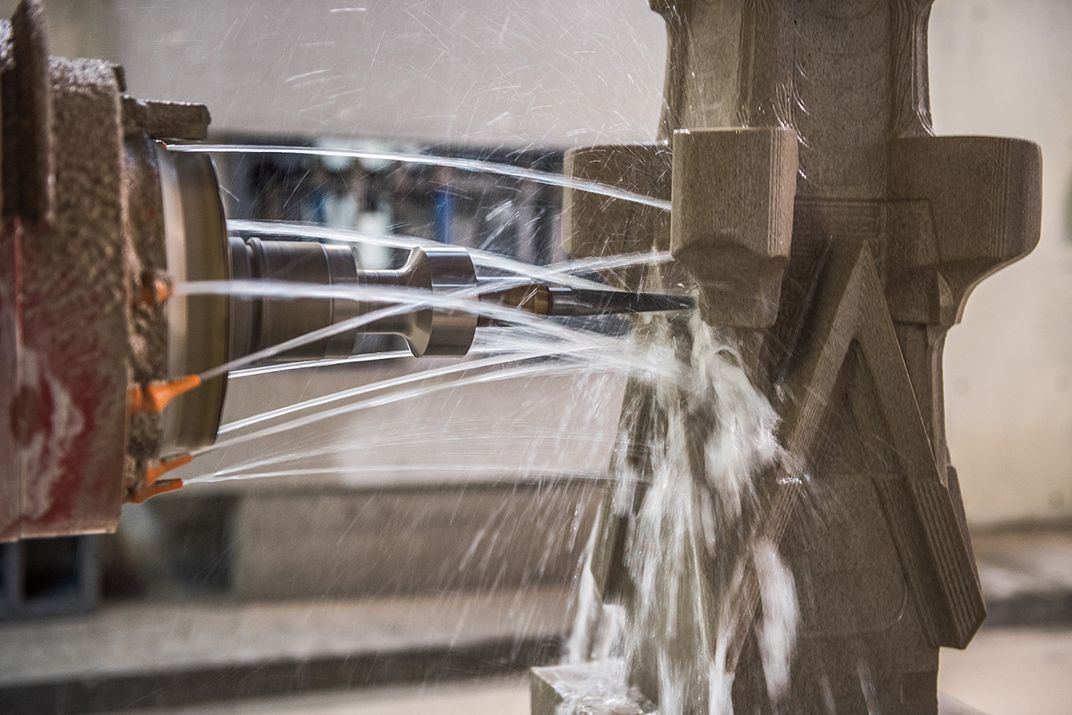
New Technology
In order to speed up the work and reduce costs, the carvers combine age-old techniques with cutting-edge advances in 3-D scanning and robotics. Using damaged stones as templates, offsite engineers make 3-D digital scans of the stone elements. A computer-guided robotic carving device then roughs out a replica from a block of Indiana limestone, creating a piece that is 75 percent complete. The roughed-out stone then goes to Callahan and Uhl in the shop to carve the fine details and finishing touches by hand.
“In the last eight years, the robotic and scanning technology that’s out there, it’s come a long way,” Alonso says. “So we’ve got this incredible technology that’s aiding us in the restoration work. It’s a big help.”
“It saves us the hard labor of physically removing large pieces of stone,” Callahan says. “The way we’re doing it now, it’s assisting us, and that’s a good thing. We can work together. The cathedral still wants the hand-done quality of what we do, so you don’t want the robot to go too close. We’re trying to grapple with how close do we get it and still have it be a hand-done piece.”
Although using robotically roughed out stones saves time and money, there is a downside to this new technology. The process of roughing out is one of the major ways that apprentices learn the craft. Alonso, Callahan and Uhl all expressed concern for how to balance the need to reduce costs and keep carving viable in today’s modern age with the need to preserve a critical means of training for artisans coming up in the craft.
“The way to learn to cut and carve is by roughing out,” Alonso says. “You learn by taking a block of stone and working it down, and learning the feel of that tool. It takes months to get the feel of it.”
In carving workshops and on job sites, the fine detail work would never be undertaken by a novice carver. Mastering the craft requires years of hands-on experience, working with the tools and materials, developing dexterity and control, a steady hand and trained eye.
“You need time on the material to become efficient with it,” Callahan says. Alonso agrees. “You can’t take a robotically roughed out piece and give it to an apprentice and say, ‘Okay, here.’ It’s all those years and time spent roughing and shaping so that you’re able to do the beautiful veining, the embellishment.”
The craftsmen’s concerns raise important questions about the role of new technology in the building arts and the need to foster and ensure the continuity of hand craftsmanship—the human touch of the artisan that gives beauty and meaning to our built heritage.
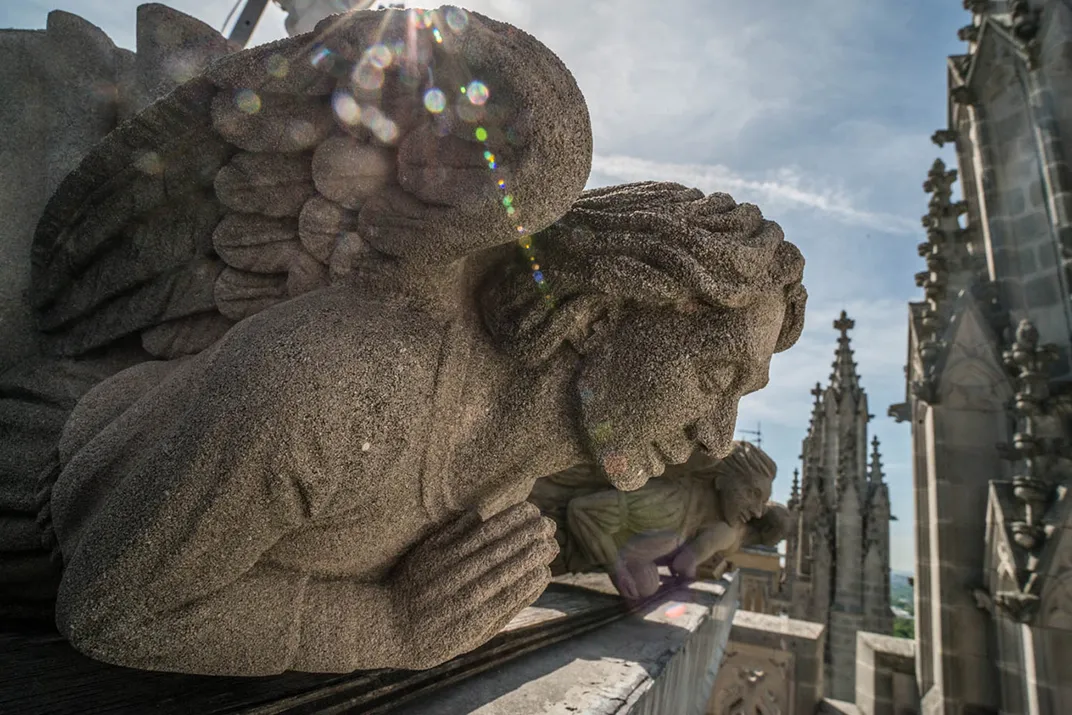
Looking to the Future
Like generations of stone carvers and masons before them, Callahan and Uhl were fortunate to learn the stone carving craft from a master stone carver, Vincent Palumbo, in a traditional apprenticeship environment at the cathedral. Alonso was taught Gothic-style masonry construction techniques on the job site by master mason Billy Cleland, “a true gentleman and patient teacher,” who, in turn, learned from his predecessor at the cathedral, the great Scottish American mason Alec Ewan. But today there is no craft training taking place at the cathedral.
“We don’t have apprentices right now, here, and that’s something that I get a little distressed about sometimes,” Alonso says. “Andy, Sean and I, we’re all in our 50s now. What do we have left? I have nine, ten years, I hope. We’re at a point now where we need to really think hard about passing on this knowledge.”
The problem is a difficult one. It takes funding to support and train apprentices. Budgets are tight at the cathedral, and there is still an enormous amount of funding the cathedral must raise to complete the earthquake repairs, on top of day-to-day maintenance and preservation work. Limited resources mean that the restoration project is necessarily deadline driven; there’s not much time to teach on the job. The situation is not limited to the cathedral: It is a major issue nationwide.
For decades, the skilled building crafts have been in decline. There are not enough young people “coming up in the trades,” and traditional contexts for apprenticeship and training have been shrinking. Pathways to existing training programs and learning opportunities are largely hidden and difficult to discover. Very importantly, there needs to be a strong, steady demand for these craft skills, not only in historic preservation, but in new building, in order to ensure enough work for artisans to sustain a livelihood. One of the main obstacles facing the building arts is the fact these trades are undervalued in today’s society; they are not given the recognition and respect they deserve. The reality is that traditional building crafts are endangered in the United States, and, with them, the ability to preserve and safeguard our nation’s cultural heritage.
As far back as 1968, a report commissioned by the National Trust for Historic Preservation stressed the urgent need to conserve the traditional building crafts, stating, “The survival of these crafts will require the most thoughtful solutions to human as well as economic problems. . . . A solution based on a national realization of the importance of these skills to our continuing culture.” More than 50 years later, many of the same challenges to the survival of traditional craftsmanship persist.
When Hurricane Hugo severely damaged historic homes and landmarks in Charleston, South Carolina, in 1989, the realization that there were not enough skilled artisans available to restore the city’s unique architectural heritage was the driving force behind establishing the American College of the Building Arts to help train a new generation of craftspeople. Masters of the crafts of stone carving, brick masonry, woodworking, plastering and blacksmithing were in short supply.
The devastating fire that swept through Notre-Dame de Paris on April 15, 2019, threw into high relief the need for skilled craftspeople to tackle the mammoth preservation effort required to restore and safeguard this iconic cultural treasure for present and future generations. In a July 20, 2019, piece for NPR piece entitled “Notre Dame Fire Revives Demand for Skilled Stone Carvers in France,” correspondent Eleanor Beardsley spoke with Frederic Létoffé, the president of the monuments restorers’ professional organization in France. He stated: “Our work involves very specific requirements and we are short of skilled labor in a dozen or so traditional professions. But the Notre Dame fire woke the country up. . . . Notre Dame made people realize that these skills are still needed and still important.”
“Historic preservation requires the preservation of knowledge and skill as well as buildings,” writes folklorist Henry Glassie. In recent years, important steps have been taken to revitalize and sustain traditional craftsmanship in the United States, including innovative outreach and training programs provided by the American College of the Building Arts, the National Park Service’s Historic Preservation Training Center, the Preservation Trades Network, the International Masonry Institute, the Timber Framers Guild and the National Trust for Historic Preservation’s HOPE Crew (Hands On Preservation Experience), to name just a few. There has been increased awareness on the part of architects, engineers, builders, preservation specialists, building owners, policymakers and the general public of the importance of quality craftsmanship and materials, and the value of the skilled trades to design, preservation and sustainability.
These are encouraging signs, but there is still much that needs to be done to foster the continuity of these centuries-old crafts—to recognize and honor building artisans for their invaluable contributions to architectural projects, and to nurture and encourage young people who want to become skilled stewards of our built environment.
Craftspeople in building arts—like the Washington National Cathedral’s great artisans Joe Alonso, Sean Callahan and Andy Uhl—play a critical role in safeguarding cultural heritage. They help communities preserve old places that hold treasured memories and meaning, identity and history. They create new structures of beauty and excellence that inspire and enrich us all. Their vast store of accumulated knowledge and skill needs to be preserved and passed onto future generations for the benefit of our shared humanity.
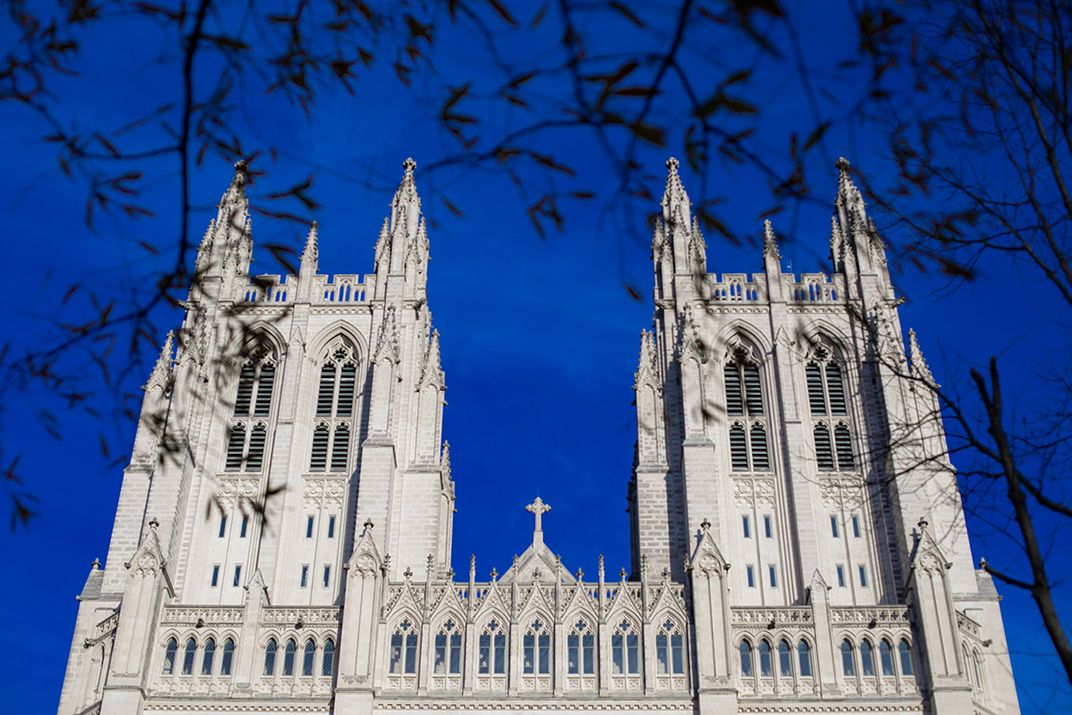
Marjorie Hunt is a folklorist and curator with the Center for Folklife and Cultural Heritage. Her grandfather, Pasquale Peronace, was a stone mason who immigrated to Philadelphia in the early 1900s from a small village in Calabria, Italy. Conducting research and fieldwork with artisans in the building trades is one of her great passions.

